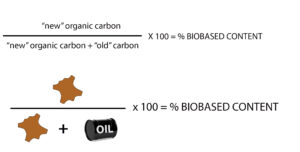What is biobased content?
It is a measure of “new” carbon or recent organic carbon compared to the amount of “old” carbon. New carbon originates from renewable biological sources (such as plants, animals, forests, marine, feedstocks, etc.) and old carbon is predominantly from petroleum-based products.
For example, oil extracted from a plant is 100% biobased and oil derived from petroleum fractioning is 0% biobased. They can have the same chemical composition, but one is from a renewable source the other not.
How is biobased content calculated?
In the diagram below, the biobased content refers to the hide and not the final leather end product:

What is the significance of biobased content?
The higher the amount of biobased content the higher the amount of renewable carbon. The production of renewable carbon is made by the capture of carbon from the atmosphere, in practical terms cleaning the air.
Are biobased products more biodegradable? The terms Biobased and Biodegradability are not interchangeable. There is no correlation between the two.
How much biobased content does leather have?
Animal skins have 100% renewable carbon. The transformation of skins to leather is made with some petroleum-based products. This reduces the amount of biobased content in the leather, but most leathers still have more than 80% biobased content.
Having 80% biobased content is generally considered good in terms of sustainability and environmental impact. A higher biobased content indicates that the product or material relies more on renewable resources, which can help reduce the overall carbon footprint and dependence on non-renewable fossil fuels. Products with high biobased content are often seen as more environmentally friendly and can contribute to mitigating climate change and promoting sustainable practices.
How is biobased content measured?
The most widely used test methods are ASTM D6866 (USA) and EN 16785-1 (Europe).
Literature:
USDA has an extensive list of biobased products in the Biopreferred Program
Biobased content on leather and alternative materials can be found in this Publication